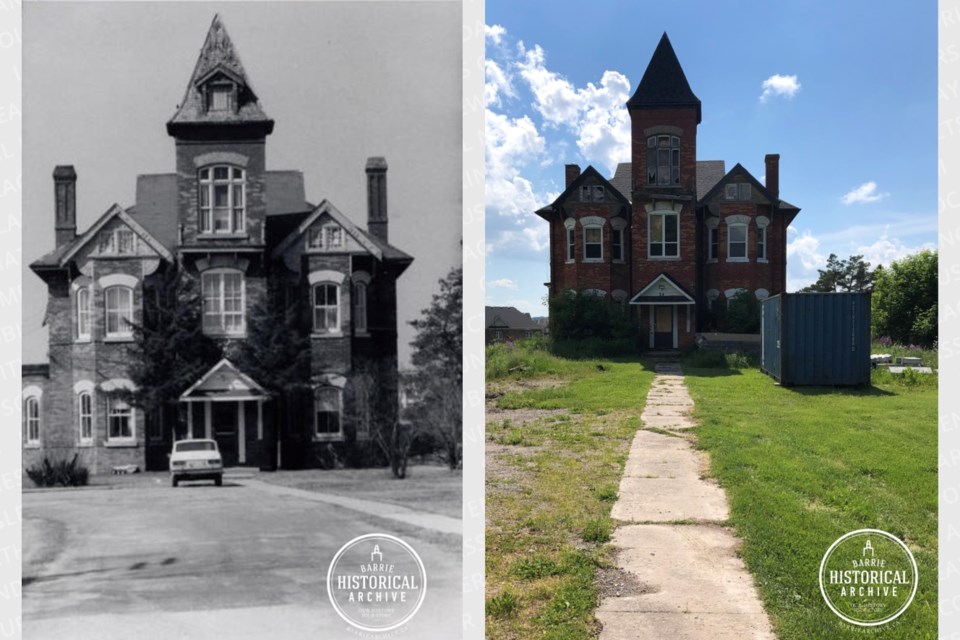This ongoing series from Barrie Historical Archive curator Deb Exel shows old photos from the collection and one from the present day, as well as the story behind them.
Ravenscraig (34 King St., Cookstown)
One of Barrie’s earliest pioneers, John Perry, for whom Perry Street was named, once had a small hamlet named for him as well.
John and Elizabeth Perry arrived in Innisfil Township around 1826, building a log tavern on the southwest corner of what would become known as Perry’s Corners.
Although one record indicates Perry received his Innisfil Crown land in 1844, Andrew Hunter’s A History of Simcoe County lists the Perrys moving to Barrie from Innisfil sometime before 1837.
Years later, a Mr. Dixon built a tavern on the Essa corner and the settlement became Dixon’s Corners.
On the Tecumseth corner, Thomas Cooke, who owned a sizable amount of property, gave the four corners a new name in 1847, Cooke’s Town, when he registered lots for sale under this name at the county Registry Office in Barrie. We now know this place, and its four corners, as Cookstown.
Thomas Cooke, born 1794 in Carrigallen, County Leitrim, Ireland, married an Innisfil girl in 1827, Mary Ann Kidd, daughter of James Kidd, another early settler to the area.
The Cookes built a small frame house in the 1830s on their 160-acre farm. They would have six children: Mary Ann, Sarah Jane, Christopher, Thomas, George and James.
Mary Ann died in 1851 and Thomas died in 1875. Both were laid to rest in the Lewis Burying Ground (Cookstown United Church Cemetery).
Christopher was drawn to public matters and, in 1861, he became a justice of the peace.
That same year, he was a major organizer and lieutenant of a band of volunteers at the time of the Trent Affair, a diplomatic incident that occurred during the Civil War. He continued to lead this company, the No. 3 35th Regiment V.M. Simcoe Foresters, for a number of years, with the rank of captain, participating in the 1866 Fenian Raids, and later as a major in the North-West Rebellion of 1885.
Christopher built an addition on the original frame dwelling in 1868, which began the transformation to the opulent Ravenscraig. The large brick home was meant for entertaining, with its generously wide doors to allow women in crinolines to enter without turning sideways, an orchestra pit and the largest ballroom north of Toronto.
The house featured beautiful panelled walls, impressive hallways and coloured glass in the windows. The 11 bedrooms and a powder room completed this lavish home.
In 1872, the already sumptuous building was made even more glorious with the installation of a brick furnace, gas lighting and a spectacular chandelier.
Cooke continued to be active in municipal concerns, serving several terms as first deputy reeve. In 1880, he was elected warden of Simcoe County.
Also in 1880, Christopher met a young music teacher, Anna Sophia Meikle. Anna, born in Meaford and raised in Bradford, attended private schools. It was while teaching piano and harp in Cookstown that she met and married Capt. Christopher Cooke.
Anna was said to be quite the socialite. The magnificent Ravenscraig was perfectly designed for the scale of entertaining she enjoyed. It was reported that the couple hosted 30 parties in their splendid home in one season alone, during the early 1880s.
Unfortunately, the story goes that Anna’s extravagant lifestyle depleted the Cooke fortune, resulting in the sale of the, by then, 145-acre wheat farm, the barns and the grand home, Ravenscraig.
The couple moved to Toronto, but summered at their cottage in Belle Ewart on Lake Simcoe.
Christopher died in 1914 and Anna died in 1937.
Ravenscraig was purchased in 1907 by Dr. Robert Leadlay, a veterinarian, related to Henry Leadlay, who owned the Union Hotel at the corner of King and Queen streets in Cookstown.
Dr. Leadlay farmed and raised foxes on the property, selling off a portion of the land for a subdivision. The Leadlays sold the Ravenscraig estate to Wesley and Olive Hindle in 1956.
The Hindles renamed the old mansion Hindle Manor and converted the building into six apartments.
If you visit Ravenscraig today, you will find it fenced off and seemingly in the middle of a construction zone.
But this story has a happy ending. Rather than demolishing the old brick building, the developers, Colony Park Homes, are incorporating the historic Ravenscraig into their community project.

